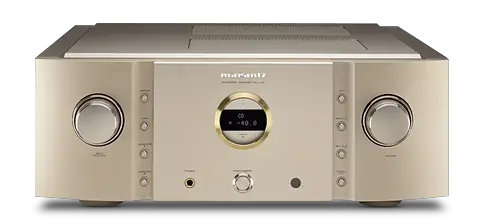|
Stereo Integrated Amplifiers By Chuck Hawks  An integrated amplifier is a pre-amplifier/control center and a power amplifier combined on the same chassis. This simplifies the stereo system and eliminates the RCA cables otherwise required to connect a separate pre-amp to a power amp. Another benefit is lower cost, as one chassis is considerably cheaper than two. Often a component manufacturer will offer an integrated amp that essentially combines the circuitry of their separate pre and power amps from the same line. For example, the Marantz Reference 11 Series integrated amplifier Model PM-11S2 ($4000) is roughly equivalent to the Reference series SC11S1 pre-amp ($3000) plus SM11S1 power amp ($4000). (The prices quoted are 2011 MSRP.) On the other hand, an integrated amplifier has never had quite the cachet of separate pre and power amps among audiophiles. This is because combining a component that handles low level signals (the pre-amp) on the same chassis with one that generates high amplitude signals (the power amp) generally degrades the performance of the former due to interference from the latter. Power amps also generate more heat than pre-amps and heat is bad for electrical circuits. The more power (watts) you need to drive your loudspeakers, the more attractive a separate power amplifier becomes. In addition, if your control center or power needs change in the future, you can upgrade a pre-amp without changing your power amp, or vice-versa. This is, obviously, impossible with an integrated amplifier. Careful circuit design, comprehensive shielding and cooling minimizes these effects in high end integrated amplifiers and, in fact, the signal to noise ratio, total harmonic distortion, frequency response and output power are identical for the PM-11S2 and SM11S1. The PM-11S2 includes pre-out and main in jacks, so that the pre and power amp functions may be accessed separately, allowing active bi-amping in combination with a separate stereo power amp. It also allows bridged mono operation. There is little, if any, loss of flexibility compared to separates. While we are on the subject, to illustrate just how good a modern integrated amplifier can be, here are the performance specifications for the Marantz PM-11S2:
An integrated amplifier and separate AM/FM tuner are usually superior to a receiver (a tuner and integrated amplifier combined on a single chassis). This is because a tuner is designed to receive very low-level transmitted signals and putting that circuitry in such close proximity to power amplifier circuitry is definitely not an optimum condition for tuner operation. Much better than a receiver, and somewhat better than an integrated amp with a separate tuner, is to combine the pre-amp and tuner functions on a common chassis and use a separate power amp. This logic here is the tuner and pre-amp are both handling low-level signals and are therefore less likely to interfere with each other. Altec-Lansing, Marantz and McIntosh once offered excellent tuner/pre-amps and Adcom, NAD, Rotel, B&K, AudioSource and others still may. However, the combined tuner/pre-amp has never really caught on with the average Hi-Fi consumer. The PM-11S2 includes pre-amplifier circuitry for magnetic phono cartridges, but these days many integrated amps do not. If you are a vinyl junkie, this is something you want to verify before buying an integrated amplifier. When repairs are needed, removing a power amplifier from a stereo system is less hassle than removing an integrated amplifier. From the standpoint of serviceability, an integrated amplifier is more crowded internally and therefore more difficult to work on. Good components are very reliable, so this is not a big deal, but anything made by man eventually needs repair or replacement. If I were to rank the desirability of the common stereo power trains (plus an AM/FM tuner as program source), it would look like this:
Is there a discernable sonic difference between these various power trains? That is, of course, the big question. The answer is going to depend on the listener and the quality of components compared. I will say that, for me, I cannot hear a difference between the integrated PM-11S2 and a SC11S1 pre-amp plus SM11S1 power amp. However, these are all excellent Marantz components from the same series designed to the same specifications. A less expensive integrated amplifier might not be able to hold its own with separates. Most integrated amplifiers are built to a lower price point than the PM-11S2 I have used as an example in this article and cannot equal its power, performance and flexibility. If you choose an integrated amplifier to control and power your stereo music system, make sure that it meets your present and anticipated future needs. |